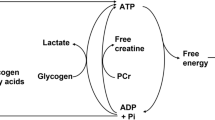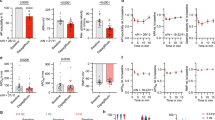Summary
Looking for a supposed digitalis-like action of compounds of the trace element vanadium, we have investigated the influence of vanadate (Na3VO4) on beating and on active cation flux of [42K+] and [86Rb+] in cultured rat heart muscle cells:
Na3VO4 (10−6–10−3M) exerts a positive chronotropic effect and increases contraction velocity and beating automaticity of the cells. Vanadate-induced alteration of beating is paralleled by stimulated uptake of [42K+] and [86Rb+] up to 75%. This stimulation has to be attributed to increased activity of (Na+ +K+)-ATPase and cannot solely be explained by the enhanced beating frequency. In contrast to ouabain, vanadate raises intracellular potassium content up to 15% and prevents cell contractures of ouabain-intoxicated heart muscle cells.
The experimental data speak against a possible digitalis-like action of vanadate in cultured rat heart muscle cells.
Zusammenfassung
Im Hinblick auf eine vermutete digitalisähnliche Wirkung von Verbindungen des Spurenelementes Vanadium haben wir den Einfluß von Natriumvanadat (Na3VO4) auf Kontraktionsverhalten und aktiven Kationenfluß von [42K+] und [86Rb+] in kultivierten Rattenherzmuskelzellen untersucht:
Na3VO4 (10−6–10−3 M) wirkt positiv chronotrop und erhöht die Kontraktionsge-schwindigkeit sowie die Automatieneigung der Zellen. Den Veränderungen des Kontraktionsverhaltens läuft eine gesteigerte Aufnahme ins Zellinnere von [42K+] und [86Rb+] (bis zu 75%) parallel. Diese Stimulation ist auf eine erhöhte Aktivität der (Na++K+)-ATPase zurückzuführen und läßt sich nicht allein durch die erhöhte Kontraktionsfrequenz erklären. Im Gegensatz zu Herzglykosiden bewirkt Vanadat eine Steigerung des intrazellulären Kaliumgehaltes bis zu 15% und verhindert in g-Strophanthin-intoxikierten Zellen die Ausbildung von Kontrakturen.
Die experimentellen Befunde sprechen gegen eine digitalisähnliche Wirkung von Vanadat in kultivierten Rattenherzmuskelzellen.
Similar content being viewed by others
References
Cantley, L. C. Jr., L. G. Cantley, L. Josephson: A characterization of vanadate interaction with the (Na, K)-ATPase. Mechanistic and regulatory implications. J. Biol. Chem.253, 7361 (1978).
Cantley, L. C. Jr., L. Josephson, R. Warner, M. Yanagisawa, C. Lechene, J. Guidotti: Vanadate is a potent (Na, K)-ATPase inhibitor found in ATP derived from muscle. J. Biol. Chem.252, 7421 (1977).
Cantley, L. C Jr., M. D. Resh, G. Guidotti: Vanadate inhibits the red cell (Na, K)-ATPase from the cytoplasmic side. Nature272, 552 (1978).
Erdmann, E., W. Krawietz, G. Philipp, I. Hackbarth, W. Schmitz, H. Scholz, F. L. Crane: Purified cardiac cell membranes with high (Na++K+)-ATPase activity contain significant NADH: vanadate reductase activity. Nature278, 459 (1979).
Gardner, J. D., H. L. Klaeveman, J. P. Bilezikian, G. D. Aurbach: Effect of β-adrenergic catecholamines on sodium transport in turkey erythrocytes. J. Biol. Chem.248, 5590 (1973).
Hackbarth, I., W. Schmitz, H. Scholz, E. Erdmann, W. Krawietz, G. Philipp: Positive inotropism of vanadate in cat papillary muscle. Nature275, 67 (1978).
Halle, W., K. D. Jentsch: Aktuelle Probleme der Wirkstofforschung. 6. Mitteilung: Zur Verwendung tierischer Zell- und Gewebekulturen für die Erfassung und Aufklärung biologischer Substanzwirkungen — Pharmakologische Untersuchungen an Herzzellen. Die Pharmazie29, 433 (1974).
Krawietz, W., K. Werdan, E. Erdmann: Stimulatory effect of vanadate on the adenylate cyclase of cardiac tissue. Biochem. Pharmacol.28, 2517 (1979).
Polinger, I. S.: Separation of cell types in embryonic heart cell cultures. Exp. Cell. Res.63, 78 (1970).
Sinclair, A. J., H. A. Miller, D. C. Harrison: An electrooptical monitoring technique for heart cells in tissue culture. J. Appl. Physiol.29, 747 (1970).
Werdan, K., G. Bauriedel, M. Bozsik, W. Krawietz, E. Erdmann: Effects of vanadate in cultured rat heart muscle cells: vanadate transport, intracellular binding, and vanadate induced changes in beating and in active cation flux. Biochim. Biophys. Acta597, 364–383 (1980).
Yamanoto, S., T. Akera, T. M. Brody: Sodium influx rate and ouabain-sensitive rubidium uptake in isolated guinea pig atria. Biochim. Biophys. Acta555, 270 (1979).
Tritthart, H. A., B. Koidl, H. Windisch: Effects of vanadate on action potentials and tension development in papillary muscles and cultured heart muscle cells. Basic Res. Cardiol.75, 472–477 (1980).
Bello-Reuss, E. N., T. P. Grady, andD. C. Mazumdar: Serum Vanadium in Chronic Renal Disease. Ann. Intern. Med.91, 743 (1979).
Author information
Authors and Affiliations
Additional information
With 1 figure
Supported by Wilhelm-Sander-Stiftung 14/1978-We 1 and Deutsche Forschungsgemeinschaft (ER 65/2).
Rights and permissions
About this article
Cite this article
Werdan, K., Bauriedel, G., Bozsik, M. et al. Regulation of active cation flux by vanadate in beating rat heart muscle cells in culture. Basic Res Cardiol 75, 466–471 (1980). https://doi.org/10.1007/BF01908413
Issue Date:
DOI: https://doi.org/10.1007/BF01908413




